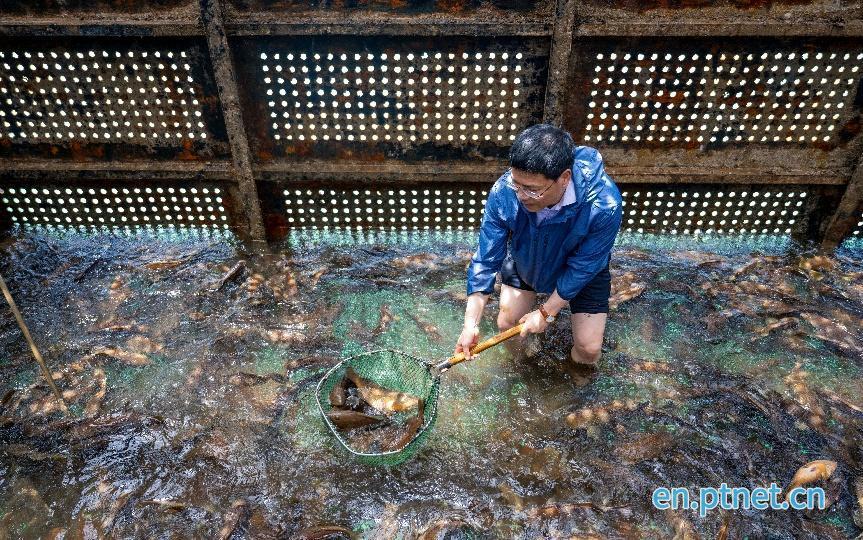Pingtan's deep-sea steel cages breed "golden grouper" selling for up to 800 yuan per kilogram
en.ptnet.cn | Updated:2025-08-07 | Lin Kongbo, StephaniePingtan, a comprehensive experimental zone off Fujian's coast and the mainland's closest point to Taiwan, is making waves with an innovative deep-sea aquaculture technique. Its subsea steel cages now yield premium groupers, fetching high prices in the market.
At dawn on July 29, sunlight cut through the mist, casting ripples across the sea near Guanjiang Village. A crane's arm stretched slowly, its steel cables arcing sharply in the dawn light. Metal groaned and a massive cage was hoisted from the water, seawater gushing through its holes to splash onto the deck. Workers in non-slip boots moved steadily, clearing barnacles from the cage with iron rods. Inside, over a thousand red-spotted groupers thrashed and jumped, occasionally slamming against the cage walls with hollow thuds.

Gao Xiang inspects the growth of groupers in the subsea caissons. (File photo)
"Look at this crazy catch!" shouted Gao Xiang, his sun-leathered face breaking into a grin as he rapped the dripping cage. The founder of Pingtan Haitan Bay Grouper Aquaculture gestured to the frenzied fish within: "Three-year-olds, raised in our engineered subsea caissons. These structures withstand typhoon-force seas while creating stable currents—mimicking their natural habitat."
Gao began exploring deep-sea farming back in 2013. "Traditional inshore farming relies on tides for water flow, which is stagnant and leads to frequent fish diseases. A single typhoon could ruin a year's work," he said, pointing to the cage's holes, his nails caked with sea mud. "After seeing data on foreign island reef aquaculture, I thought Pingtan's marine conditions were perfect for deep-sea farms."
Early attempts failed, though. "We first used cylindrical iron cages but miscalculated the hole size. When currents hit, fish battered the walls of the cages—when the fish were pulled up, many were stripped of scales," Gao recalled. "Typhoons were worse: huge waves flipped the cages, slamming them into reefs and killing most fish."
In 2015, Gao's team redesigned, switching to steel plates. "We tested hole densities repeatedly, making countless templates. Finally, we settled on 20% water permeability—enough for smooth water exchange, yet stable enough for the fish. That's when we got it right," he said.
Today, 40 steel cages—each 6 meters square and 15 tons—stand firm in 15 to 20 meters of water off Guanjiang Village. "Deep-sea currents act like a 'natural purifier,' slashing disease risks. It's also a 'safe haven'—hardly affected by typhoons or red tides," Gao said proudly. "Each cage holds about 2 tons of fish, with a 60% survival rate. Now I sleep soundly even during typhoons."
The rewards are tangible. "Deep-sea groupers have firm flesh, almost as good as wild ones. They sell for 300 to 400 yuan per 500 grams around Spring Festival, with annual sales hitting about 10 million yuan," Gao noted.

Fishermen are engaged in operations on a subsea caisson. (File photo)
This reliable model has also helped local fishermen switch careers. "We have over a dozen staff, mostly local fishermen, handling sea operations, sales, and logistics," Gao said. Freed from the uncertainty of traditional fishing, they've become skilled workers in aquaculture. Chen Songfa, feeding the fish, straightened up with a simple smile: "Stable income makes work more rewarding."
Recognized this year on Fujian's inaugural list of endorsed marine technologies, Gao's team now prototypes larger cages capable of holding 12 tons of fish with six times more capacity.
Meanwhile, Pingtan's first deep-sea aquaculture industrial park advances—a 150 million-yuan venture spanning 3,000 mu of ocean. Its pilot phase will deploy three colossal cages supporting 600 tons of annual yield. "Construction is set to start in the fourth quarter," said Yan Dong, deputy director of Pingtan's Agriculture and Rural Bureau.

 Fujian Public Security Registration Code: 35012802000271
Fujian Public Security Registration Code: 35012802000271